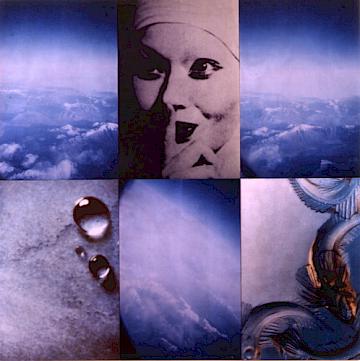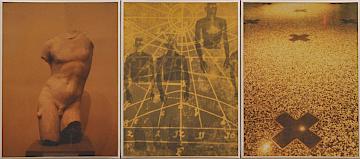Birgit Jürgenssen. Galerie Hubert Winter
Four pieces of thin iron bars are welded together to form a neat rectangle (ph937) . Matte-coated, the piece has an elegant yet robustly industrial look. One can see some rust and damage on its surface, results of the decades it has spent in storage. Rather than a forgotten minimalist sculpture, this is one of the purpose-built frames from late Austrian artist Birgit Jürgenssen’s photographic series Stoffarbeiten (Cloth Works) produced between the late 1980s and early 1990s.
. Matte-coated, the piece has an elegant yet robustly industrial look. One can see some rust and damage on its surface, results of the decades it has spent in storage. Rather than a forgotten minimalist sculpture, this is one of the purpose-built frames from late Austrian artist Birgit Jürgenssen’s photographic series Stoffarbeiten (Cloth Works) produced between the late 1980s and early 1990s.
The series consists of photographic prints mounted on stretched canvases, which are screwed directly to the iron frames built by the artist herself. In place of framing glass, she used thin, translucent fabrics such as gauze or voile (hence the series’ title), veiling the images and giving them a hazy sheen. The photographs themselves form something of a dictionary of experimental photographic processes, including photograms and cyanotypes; solarized and multiply-exposed images. Nineteen suites of one to fifteen pictures from this series are presented in this exhibition. mehr
The sculptural presence of these photographs is striking. The juxtaposition of hard welded iron and delicate textile reinforces the tactility of these works, and a fact that is so obvious but often overlooked in theories of photography: that every picture is an object and every surface has its material support. By employing such an idiosyncratic framing device, Jürgenssen managed to address resolve the ways in which material conditions influence the reception of an image.
The images comprise a complex amalgam of formalist abstraction and Surrealist iconography: pictures of flowers, antique statues and female figures are complimented by abstract photographs manipulated in the dark room. Jürgenssen’s interest in Modernist formalism is particularly conspicuous in Untitled (ph940) (1990), a diptych showing close-ups of a crumpled textile. Framed by another kind of textile, these images of fabric are clearly a commentary on the Modernist preoccupation with self-referentiality. Three Jumping Men (ph939)
(1990), a diptych showing close-ups of a crumpled textile. Framed by another kind of textile, these images of fabric are clearly a commentary on the Modernist preoccupation with self-referentiality. Three Jumping Men (ph939) (1988) is a triptych consisting of a colour photograph of a classical sculpture of a male torso, a semi-abstract, double-exposed image showing a cryptic diagram and men exercising, and another colour photograph of a stone floor with a black-cross pattern. This concise suite seems to be a humorous reference to Russian Constructivism and Kazimir Malevich in particular.
(1988) is a triptych consisting of a colour photograph of a classical sculpture of a male torso, a semi-abstract, double-exposed image showing a cryptic diagram and men exercising, and another colour photograph of a stone floor with a black-cross pattern. This concise suite seems to be a humorous reference to Russian Constructivism and Kazimir Malevich in particular.
These works demonstrate Jürgenssen’s deep understanding of the formalist and Constructivist traditions as well as her mastery of Surrealist visual language. Indeed, much of the works presented here seem to share a close affinity to the early Bauhaus period when the Expressionist/Surrealist and formalist/Constructivist camps were battling for stylistic and ideological supremacy. However, this reading does not fit comfortably with the conventional understanding of Jürgenssen’s works which situate her practice squarely within the Feminist interpretation of Surrealism and exploration of ‘womanness’. To complicate the matter further, the presence of appropriated images reveals an awareness of contemporary debates on representation and originality – concerns most commonly associated with the Pictures Generation.
The fact that most of the works in this exhibition were previously unshown to the public, and that they are only part of a larger series, gives some indication to the immensity and complexity of Jürgenssen’s oeuvre – one shockingly neglected during her lifetime. Furthermore, these works expose the inadequacy of the existing debate on her work which disproportionately focuses on representations of femininity in her practice. What this series shows is Jürgenssen’s formalist concern for material and process, her competence in sculptural production and an understanding of contemporary artistic discourse beyond her immediate circle in Austria.